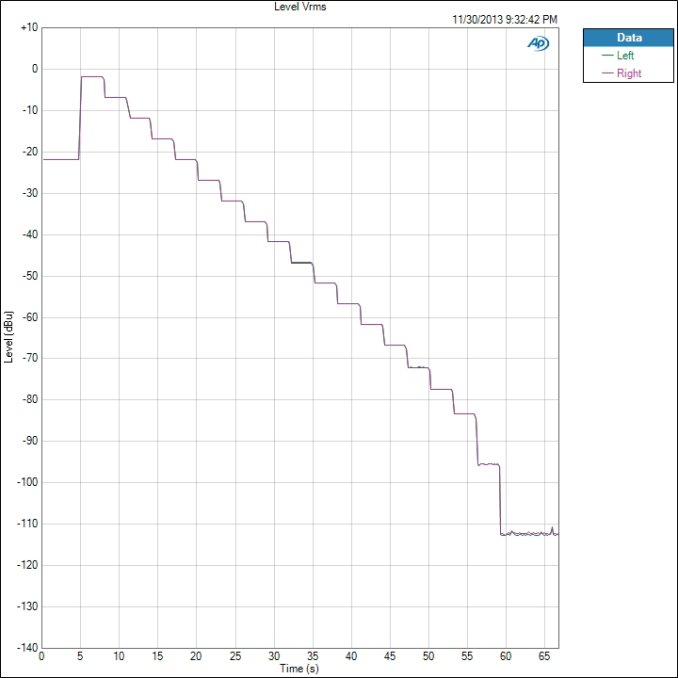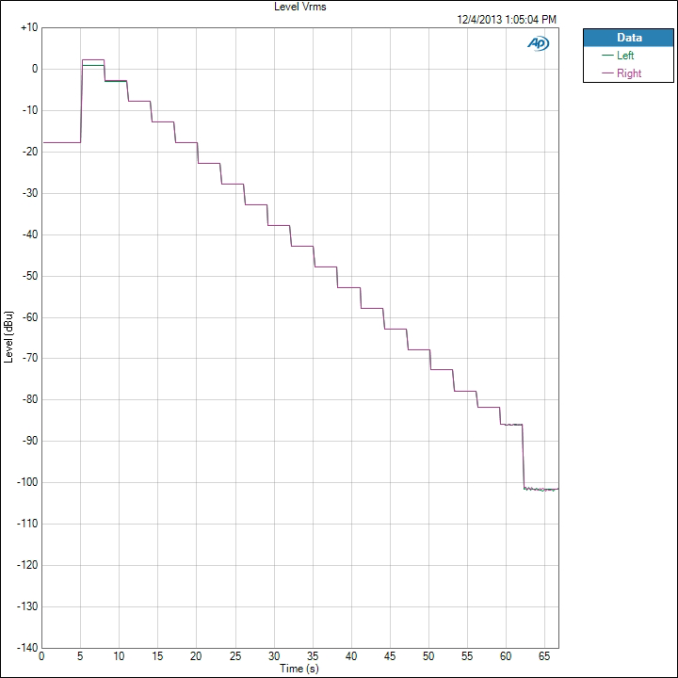Smartphone Audio Quality Testing
by Chris Heinonen on December 8, 2013 5:15 PM EST- Posted in
- Smartphones
- Audio
- Mobile
- Tablets
- Testing
Dynamic Range
The dynamic range of the phone indicates the difference between the loudest possible sound and the background noise. The more residual noise in the background, the lower the dynamic range. Phones with more powerful amplifier sections will typically produce a greater dynamic range. The residual noise level is often constant, so as the overall volume level increases the difference between the music and the noise increases as well.
The best performer here is the iPhone 5 again, with 92.214 dB of range. The worst is the Nexus 5 with only 89.332 dB. A difference of 3 dB is not something I would concern myself over. If we see a phone or tablet that drops down below 80 dB then I will start to show more concern.
Crosstalk
Crosstalk, like dynamic range, is just a number here. This is the measurement how much signal leaks from one channel into another. If an instrument should only be in the right ear, some of that signal will leak into the left ear, but we want that as low as possible. The results are expressed in -dB, or how much quieter one ear is than the intended ear.
On the Note 3 we see a wonderful crosstalk measurement of -117.2 dB so the sounds in one ear are -117 dB quieter in the other ear. This makes them impossible to hear. The worst is the iPhone 5, with only -75.624 dB of isolation.
Stepped Response
The stepped response uses a 1 kHz 0 dBFS tone but measures output level from maximum volume to minimum volume. We can see how large the volume steps are and how many there are. It doesn’t produce a number we can use, but it ties back into our other results. For a good example, we can look at the Note 3.
We see steps that are around -5 dBu each. The final level is muted and just the background noise of the device. Each step is clean and even but as we get lower and lower we see noise start to intrude. This is the background noise starting to become audible in the signal. The flatter the levels are, the quieter it will be. Now, let us look at the Nexus 5.
Notice at the very top how the right and left channels do not overlap. That is the clipping we talked about at the very beginning. It isn’t until the 4th volume setting that the level difference is down to nothing. Because of this, I would consider the top 3 volume settings of the Nexus 5 as ones that should be avoided. They each have enough THD+N introduced into them that it will sound poor, and one ear will be louder than the other.












188 Comments
View All Comments
brusselwilson - Sunday, December 8, 2013 - link
Is sample variation an issue of relevance for smartphone audio systems?cheinonen - Sunday, December 8, 2013 - link
No more than it would be with anything else I would think. For the Nexus 5 I tested two different samples (one from Brian, one from a friend of mine) and both exhibited this issue. So you might see small variations, as you would with any display or anything else, but nothing major I wouldn't think.vailr - Sunday, December 8, 2013 - link
Another factor to consider: certain cell companies can enable enhanced audio quality for cell phone calls, but only on selected cell phone models. The IPhone 5 has that ability, as I recall. Not sure about the specifics, but I believe that both ends of the cell call must be using supported phones, as well as: the cell provider must enable that feature. That would enable cell calls to have better voice quality than land line calls, via increased audio frequency response.shenkey - Sunday, December 8, 2013 - link
Could we also get Windows Phone devices included in the test. Lumia 920 and 1520 should fit in the range.cheinonen - Sunday, December 8, 2013 - link
I'll add whatever I can when I get a chance. This first run has taken almost all my time up since the week of Thanksgiving.hopfenspergerj - Sunday, December 8, 2013 - link
It's not useful to measure noise/dynamic range at the highest volume setting. You have to measure at one of the lowest settings to determine whether the phone truncates bits, whether the noise floor does not decrease with the volume setting, etc.I have an htc dna and it is completely, totally, utterly useless for playing music with sensitive IEMs; I suspect many android phones with "-90db" thd+n measurements are similarly bad in practice.
hopfenspergerj - Sunday, December 8, 2013 - link
Not to mention poor shielding on the dna causes the phone to output chirping and static and other loud extraneous noises whenever it transmits data.cheinonen - Sunday, December 8, 2013 - link
We have stepped output level charts as well that measure this, they just aren't included here right now. I can start to pull those out for current and future tests if we want to use them.evonitzer - Monday, December 9, 2013 - link
I saw that one graph included when you compared the Nexus 5 and G2 at different levels and I think it should be in all the reviews. I always run my IEM's in the lower half of the volume range so I am quite interested in how they perform. As others have said, excellent work!DoctorG - Tuesday, December 10, 2013 - link
Same here -- I always run my good IEM's below half volume at least (usually more like a third.) No point in having good headphones & music if the volume is turned up so loud it hurts....BTW Great job Chris! I have always wanted more in-depth reviews about smartphone audio quality. It's very important to me, but so far there haven't been any reliable/objective tests available. Thanks! Just a thought, but maybe it would be possible to test against a pro-quality amp/DAC? When I use my GNex, the quality is obviously very different from my audio interface that I use with ProTools. It'd be interesting to see just how much of that is measurable...